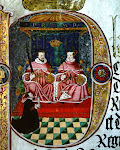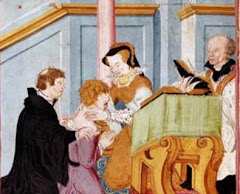
Why did you decide to write a biography on Katherine of Aragon? Was it due to an existing interest in her life story or perhaps a response to the limited amount of work on her?
There had been no serious solo biography of her since Mattingly in 1942. As a Spanish speaker with access to archives here in Spain, I felt I might be able to add something new to her story – if only by virtue of adopting a 'Spanish' perspective. In fact I have found some “new” (or, rather, previously underused) documents and have gone over many of the original documents (or transcripts of them) that can only by seen in their abbreviated, version in the Rolls Series of calendars (Letters and Papers of Henry VIII, Calendar of Spanish Papers etc...) They have allowed me, I think, to add new “shading” to her life. On a personal level, I also feel a natural sympathy for her as a 'displaced' Spaniard in England (being, myself, a displaced Englishman in Madrid, Spain). The result is “Catherine of Aragon: Henry's Spanish Queen” (note the different spelling) published by Faber and Faber in the UK and Walker in the U.S.
What is Katherine’s reputation in Spain? Every year the Spanish Embassy sends representatives to attend the commemorative services held for Katherine at Peterborough Cathedral. I was wondering whether this action was reflective of general sentiment in Spain or was just a nice gesture on behalf of the ambassador.
Katherine is barely known in Spain. She is overshadowed by her sister Juana “The Mad”, who was queen of Castile and (as her name implies) a troubled and colourful character. Katherine is a footnote in Spanish history. That footnote reads little more than this: “Victim of a wicked husband, Henry VIII”. The first proper biography written by a Spaniard (Luis Ulargui) was published just a few years ago and doesn't seem to have made much impact.
Katherine acted as Queen Regent during her husband’s military expedition to France in 1513. Do you think Katherine’s actions were heavily influenced by the example of her mother’s queenship?
Absolutely. Isabel had shown that a woman could organise a war (though not lead troops into battle, which neither Katherine nor her mother ever did), so she was by no means scared of the experience. In fact, reading her letters, she rather seemed to enjoy it. I think that, subconsciously, she probably also saw what she did in terms of the partnership that her mother and father enjoyed as monarchs of Castile and Aragon respectively – and was happy to be offering her husband victories at home, while he fought abroad. At one stage she compares their wars to her father's own conquest of Navarre, for example.
Some of Mary I’s biographers stress that it was Katherine who ensured her daughter was educated to be queen, and certainly Katherine was always confident that her daughter should rule in her own right. Would you agree that Katherine played a significant role in Mary’s education?
I am not sure that Katherine was confident that her daughter would be queen – especially not at the end. I imagine she always hoped to give birth to a son. But she certainly made sure Mary was well educated, commissioning a book from the Spanish humanist Juan Luis Vives outlining the proper education for a daughter. There is evidence that Katherine was personally active in educating Mary before she was sent off to Ludlow with her own court. She also taught her daughter absolute obstinacy in the defence of her rights (even at the risk of martyrdom, see below).
Several years ago, David Starkey argued in his study of the six wives of Henry VIII that Katherine was probably lying about the non-consummation of her first marriage, but this lie was understandable and done to protect her position and later her daughter’s. From your research would you concur, or do you think evidence points to Katherine being honest in this regard?
Starkey says that Katherine knew how to lie, and I agree with him on that – the evidence is clear in the case of her first pregnancy, for example. But I think there is good evidence that she may have been telling the truth on this particular issue. The strongest piece of evidence is that Henry never took up the opportunity of swearing on oath that she was not a virgin when they married. Was he worried for his soul if he lied? We don't know. He may, of course, not have known enough about women's biology to be able to determine whether she was a virgin or not. I have also discovered, in a Spanish archive, the evidence given by some of those who travelled with Katherine to England. They said, at a hearing at the cathedral in Zaragoza (which historians of the period either seem to be unaware of or simply ignore – I cannot say why), that the wedding night was a disaster and all was doom and gloom the following morning. The English witnesses said pretty much the opposite when questioned at a hearing at Blackfriars. Basically, there is not enough evidence either way. Certainly her father said right from the beginning that she was still a virgin, when no-one really cared. I can't see why he would lie about that, unless he wanted to get her dowry money back or foresaw the kind of challenge that Henry would later make to the marriage.
In a letter to her daughter (probably dated around late 1533), Katherine commanded her to always obey God and to remember that ‘we never come to the kingdom of Heaven but by troubles’. One recent historian (Anna Whitelock) has argued that Katherine was inviting her daughter to a sort of ‘shared martyrdom’ and that Mary adopted the principals presented in this letter. Do you agree with this?
I absolutely agree with this. Katherine inherited an intensity of character – and intense religiosity – from her mother. That made her both obstinate and tough when convinced she was in the right. She was prepared to pay the ultimate price herself (of martyrdom) and was ready to take her daughter with her, if that was the only way to save their souls (which, by her terms, would have been lost had they bowed to all Henry's demands).
Katherine of Aragon has been portrayed in film and TV productions on several occasions, including recently on the show, ‘The Tudors’. But these productions often depict her later in life and as physically different from what she actually appeared. Do you think such productions have presented a distorted and/or limited view of Katherine, or do you think they do a good job in getting people interested in her life?
I haven't watched them, I'm afraid. Ideas of beauty change over time, anyway, so I am not sure her physical aspect matters that much.
Katherine’s successor and rival, Anne Boleyn, is often the subject of much interest, so much so that there exists at least three major academic biographies on her. From your research, what are your own views of Anne Boleyn?
Anne Boleyn is fascinating, though I do not claim to be an expert on her. She was clever in all senses of the word - sometimes running rings around Henry - and a very strong character. I think Henry found her exciting as long as he could neither bed nor marry her. Once they were married (and once he was divorced) she was less of a challenge, and soon became less exciting. In fact he began to find her annoying. I can't help feeling sorry for her. She waited ages to marry him (while Katherine fought the divorce) and then lasted only a few years before having her head chopped off. Katherine's marriage lasted far longer..
Finally (sorry for all these questions!), if one was planning a trip to Spain and wished to visit sites relating to Katherine, what particular places would you recommend?
She spent so little of her life here (leaving at the age of 15) - and most of that was spent following her mother and father about on their wanderings - that there are very few places to visit. The only place she could ever really call home was the Alhambra at Granada – where she spent most of the last two years of her time in Spain. The Royal Alcazares at Seville were another place she stayed during that final period. Her birthplace of Alcala de Henares is a charming, if overbuilt, university town outside Madrid. For a symbolic place in her mother's story I recommend the Toros de Guisando (the ancient stone bulls, set in open countryside an hour's drive from Madrid, where the pact that sealed her position as heiress to the throne was agreed).

Giles Tremlett's book, Catherine of Aragon: Henry's Spanish Queen (Faber and Faber, 2010), is out now in the UK.



